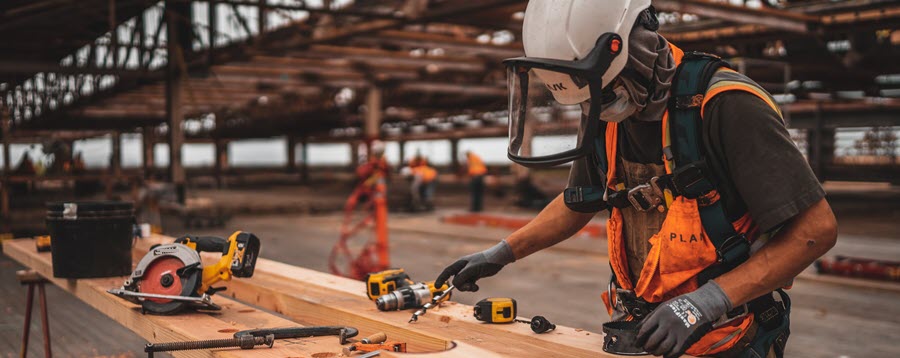
Selecting Respirators for Construction Dust

Dust and debris are part of the job for most construction workers. But construction dust can be more than a nuisance. It can also cause serious health problems. When engineering controls can’t safely control construction dust, respirators must be used. This article presents information from NIOSH about selecting a respirator for dust control.
If a workplace is in compliance with OSHA dust standards, employers can permit workers to wear air-purifying respirators. Selecting the right air-purifying respirator requires an assessment of workplace operations, processes or environments that may create respiratory hazards.
Selecting a Respirator for Construction Dust Control
NIOSH-approved air-purifying masks are available in two broad classes: non-powered and powered. Non-powered are sometimes referred to as negative-pressure respirators, while powered respirators are referred to as PAPRs (powered air-purifying respirators).
Non-powered Air-purifying Respirators
Several filter materials are available for negative-pressure respirators. Since some filters are degraded by oil mist, replaceable filter cartridges are designated according to their level of oil resistance:
- N-Series filters are not resistant to oil
- R-Series filters are oil-Resistant up to one shift
- P-Series filters are oil-Proof
For mineral dusts, such as silica, any of these filters will work unless the workplaces has an oil mist source, such as percussion drills.
The dust (or mist) collection efficiency of filter materials also varies. Filter cartridges are available in three efficiency levels: 95%, 99% and 99.97%, designated as 95, 99 and 100. For example, an N95 filter is 95% efficient; an N99 filter is 99% efficient; and an N100 filter is 99.97% efficient. The most commonly purchased filter types are N95s and P100s. Type 95 filters usually have a lower cost and breathing resistance than type 100 filters. As the letter rating and number rating increase, breathing fatigue will also increase.
Reusable Half-Masks
A reusable half-mask consists of a filter-holding unit called the facepiece or mask, fabricated from molded plastic or rubber. The mask contains intake and exhaust valves and is attached to straps that ensure a tight fit to the wearer’s face. This type of half-mask respirator has a replaceable-filter that removes dust when the facepiece seal is leak-tight. The seal can occasionally cause skin irritation. These respirators also interfere with conversation and may interfere with eyeglasses or goggles.
Filtering Facepiece Respirators (FFRs)
FFRs, commonly called dust masks are another type of negative pressure air purifying respirator. FFRs have a lighter design than half-mask respirators. The entire mask is fabricated from filter material that covers the mouth and nose. FFRs are more comfortable and require no maintenance. It may be harder to pass a fit test with an FFR than a reusable half-mask. As a result, they are often much less effective than half-masks. FFRs are certified by NIOSH under the 42 CFR 84 respirator certification tests. Certification is no guarantee that the mask will perform well as worn. In one study of FFRs, the average dust reduction was only 67%.
Powered Air-Purifying Respirators (PAPRs)
Powered air-purifying respirators (PAPRs) use a fan to draw air through a filter to the user. They are easier to breathe through than negative pressure air purifying respirators; however, they need a fully charged battery to work properly. PAPRs have three filter classes HE, PAPR100-N, and PAPR100-P. All three filter series must demonstrate a minimum efficiency level of 99.97 percent. It is important to know what the hazard is, and how much of it is in the air, to select the proper filters/cartridges. PAPRs are often designed with a hard hat equipped with a battery-powered fan or a belt-worn battery and fan, filtering system, and face visor, thus providing protection for the head, lungs, and eyes and face within one unit. Another advantage is a lack of breathing resistance. Loose-fitting PAPRs have the ability to accommodate facial hair. Tight-fitting facepiece PAPRs are required by OSHA to be fit-tested and worn without facial hair.
A Good Fit is Important
Workers should follow respirator manufacturer’s instructions, and comfort is as important as a tight seal. A worker may need to try different sizes or respirators from different manufacturers to find the best fit for his or her facial structure. Once a respirator is put on, positive and negative pressure seal checks are necessary to ensure there are no leaks that would degrade the respirator’s effectiveness.
Respirator Maintenance
Basic respirator maintenance is simple – Ensure filter cartridges are undamaged, valves are in working order, straps are not slipping or broken, and there are no tears or deformities in the facepiece. It should also be reasonably clean. Regular filter replacement is an important part of respirator use. Normally, filters should be replaced when breathing resistance increases or when they are damaged or soiled or at the end of the shift if exposed to oil mists. Another approach is to replace filters when the filter loading reaches 200 mg of dust . NIOSH has additional guidance on reuse and extended use of filters.
Selecting the appropriate respirator for the job and ensuring it is used properly helps keep construction workers safe and healthy.
Construction Respirator Resources:
- NIOSH Guide to Respirators Used for Dust in Construction
- OSHA respiratory protection page
- NIOSH fact sheet on respirator fit testing (pdf)
- Respirator signs and labels at ComplianceSigns.com
- Construction safety signs at ComplianceSigns.com

